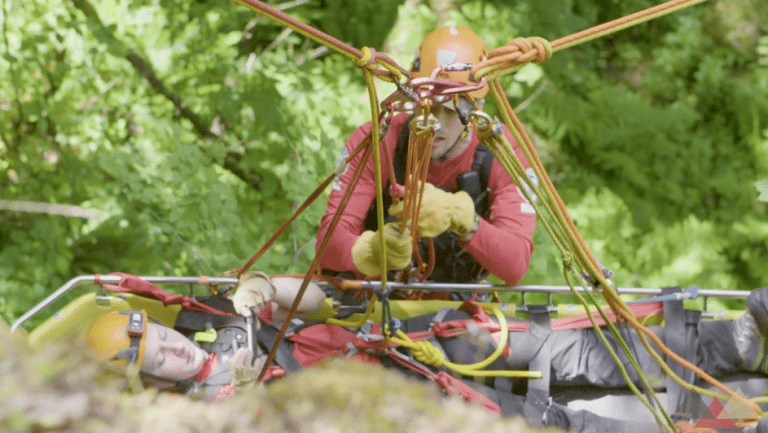Tender Line Techniques for Litter Handling
In technical rescue, proper tender line techniques are essential for safe and efficient litter handling. The tender’s role is critical: keeping the litter off their body, navigating challenging terrain, and maintaining patient safety and comfort.
By incorporating tools like ascenders, the AZTEK LT system, and etriers, tenders can improve control, minimize fatigue, and enhance their overall effectiveness. This article dives into the best practices for litter handling with proven systems and methods.
Why the Tender Line Matters
The tender line provides several benefits:
- Reduces Weight on the Tender: By keeping the litter’s load off the tender, they maintain better mobility and control.
- Improves Positioning: The tender can adjust their height and distance relative to the litter for better navigation.
- Enhances Safety: Properly using an ascender and backup systems minimizes the risk of accidents.
Key Techniques for Tender Line Management
1. Using an Ascender for Better Control
An ascender with a spring-loaded action is ideal for litter tending. It allows smooth movement up and down the line while maintaining security.
- How It Works:
- Stand up in the etrier and pull the tender line below the ascender to adjust your position.
- To descend, open the cam on the ascender, lower yourself to the desired position, and transfer weight back to the ascender.
- Backup Tip: Always tie a knot at the bottom of the tender line. This acts as a failsafe in case the ascender slips or fails.
Additional Security: Attach a runner from your harness to the ascender. Adding an etrier provides another reliable point of contact for climbing or descending.
2. Tender Positioning and Rope Management
Proper positioning ensures smooth litter handling and patient comfort.
- Optimal Position: The tender’s position should remain just below the litter railing, allowing them to:
- Keep the litter away from walls or overhangs.
- Maintain easy access to the patient.
- Navigating Overhangs:
- When passing over an edge, tenders should keep their feet high, almost level with the litter’s top rail.
- A long tail on the tender line provides flexibility for clearing obstacles like rocks or brush below the litter.
3. Using the AZTEK LT System
The AZTEK LT system provides exceptional control, reliability, and efficiency for tending litter lines.
- Key Features:
- Quick rope adjustment for ascending or descending.
- High-quality pulleys reduce friction and make movements smooth.
- Integrated prusik hitches add a layer of backup security.
- When to Use: The AZTEK LT system excels in rapid-response situations requiring quick adjustments and high mobility. It provides a seamless way for tenders to manage their position relative to the litter.
Securing the Tender for Maximum Safety
Maintaining secure contact between the tender and litter ensures stability and safety for the patient.
- Multi-Loop Straps or Web Slings: These work but may lack adjustability.
- Litter Strap and Harness Connection:
- Connect a litter strap from the end of the litter to the tender’s harness.
- This setup fights pendulum swings caused by gravity and allows the tender to position closer to the patient’s head if needed.
The High-Tender Position
The high-tender position is particularly effective for navigating challenging environments, such as overhanging edges or steep walls.
- Advantages:
- Keeps the tender away from walls, ensuring clearance of the litter.
- Allows tenders to move the rope grab higher while staying low on the line.
- Maximizes control with feet positioned high near the litter rail.
For tall tenders, this approach improves comfort and mobility while maintaining the litter at a safe distance.
Best Practices Recap
To ensure safe and effective litter handling, tenders should:
- Use an Ascender: Invest in a spring-loaded ascender and tie a backup knot at the bottom of the tender line.
- Incorporate an Etrier: Attach an etrier to the ascender for additional support and easier movement.
- Utilize the AZTEK LT System: Leverage its quick adjustments, prusik backup, and efficient pulley system.
- Maintain Proper Position: Keep feet high when passing edges, and use a long tail to clear obstacles.
- Secure the Connection: Use a litter strap to connect the tender’s harness to the litter for optimal stability.
Final Thoughts
Mastering tender line techniques is essential for efficient litter handling during technical rescues. Tools like ascenders, etriers, and the AZTEK LT system provide the control, safety, and versatility needed to navigate challenging terrain.
By following these guidelines, tenders can ensure smooth operations, minimize risks, and most importantly, keep their patients safe during transport.
Peace on your days,
Lance
Explore More at Rigging Lab Academy:












